Table Of Content

The answer is no; shaving has nothing to do with how fast your hair grows or how thick it becomes. You might think that your hair looks thicker or grows faster because of how different the new hair looks when it finally pops through your skin. The act of shaving removes the dead portion of hair, not the living section lying below the skin’s surface, which is why it doesn’t affect the rate or type of growth, according to the BMJ. While this area can have different rates of growth and thickness, Shays says most people shave their underarms every day or two, especially during the summer months.
What makes hair grow thicker?
Whether it was from your parents before your first shave or your friends when discussing grooming routines we’ve all been told that same thing at some point. Now you know that shaving doesn’t make your hair grow back thicker, the next question on everyone’s lips is, “But Gio, does shaving make hair grow back faster or is that a myth, too? You’ve guessed it, it originates from the same optical illusion that makes you think shaving makes your hair grow thicker. “No hair-removal methods have been shown to allow hair to regrow softer than what was removed,” says Dr. Miller.
When drinking water becomes a form of charity
The thickness, color, and length of hair (both vellus and terminal) largely varies depending on the individual and even varies within a single individual depending on the area. Shaving hair from our faces, legs, armpits, and other parts of the skin is a daily routine that millions if not billions of people follow. But once the allure of shaving wears off, I’m sure many of us have wondered – why did I ever shave light and fine hair?
Your hair grows back faster with shaving
Now it’s thicker, darker and results in an irritating stubble. A dermatologist is a medical doctor who specializes in treating the skin, hair, and nails. “Those with curly hair are more prone to develop folliculitis, a skin condition in which follicles become inflamed, than those with straight hair,” Marcus said. “When you shave, it does not change the thickness of the hair,” said Sara Lamb, M.D., an assistant professor of dermatology at Virginia Commonwealth University.
Debunking the Myth
Hair growth is primarily determined by genetics, hormones, and overall health. We pull the skin on our faces or legs taut just so razors can whisk away the undesired hairs sprouting on the fertile landscape of our bodies. After shaving, the hair grows back with a blunt tip and typically feels stubbly and coarse, which is why it can sometimes appear thicker. Plus, the sun and other chemical exposures have not yet lightened the new hair, making it appear darker or thicker. High school is a time filled with experimentation and a lot of learning—and we're not just talking about during school hours. For many of us, it’s a time of immense change and self-exploration.
Does Shaving Make Your Hair Grow Back Faster?
And with those many changes (both puberty-related and not) comes the inevitable body hair debate. We know puberty brings more hair growth in certain areas (more on that later), but what exactly to do with that hair—if you choose to do anything at all—isn’t so simple. When shaving your face, wash it first before applying shaving gel or cream. Be sure to gently glide the razor against the skin in the direction that your hair grows.
I cut my infant son's hair so it would grow back thicker and TikTok won't stop razzing me - New York Post
I cut my infant son's hair so it would grow back thicker and TikTok won't stop razzing me.
Posted: Fri, 06 Jan 2023 08:00:00 GMT [source]
CeraVe SA Body Wash for Rough & Bumpy Skin
(Although, in rare instances, excessive waxing, which tears a hair from its root, can eventually reduce growth from certain hair follicles due to the repeated trauma). When you shave, you’re slicing off dead hair at the surface of the skin. Since shaving doesn’t remove hair under the skin like other hair removal methods do, it’s impossible for you to affect its color, thickness, or rate of growth.
…men had the hair on their legs shaved with a straight razor and warm water. One to three weeks later, a carefully measured area on each leg was shaved and all the shavings collected. A 10 by 10 em square card was placed just below the patella, with its upper edge horizontal and centered over the patellar tendon. The card was outlined with Micropore tape and then removed.

From the time you first picked up a razor to shave your legs, you might have had someone warn you about the potential dangers or mistakes of shaving. You’ve probably heard things like shaving causes razor burns, shaving leads to ingrown hairs and perhaps the most notorious, shaving makes your hair grow back thicker. There seems to be this long-standing myth that shaving can make your hair grow back differently. To find out if there’s any truth to it, we consulted with board-certified dermatologists Dr. Jason Miller of Schweiger Dermatology Group and Dr. Marisa Garshick. Ahead, they’re doing some major myth-busting around how shaving really affects your hair growth.
It can have positive effects such as exfoliation, however, which is good for the skin. You can also prep your skin for shaving with a gentle scrub. “This will slough away dead surface skin cells, which will allow for a smooth shave and promote surface cell turnover,” in addition to minimizing the risk of ingrown hairs, she explained. To set the record straight, shaving does not make your hair grow back thicker.

On average, the hair on your scalp and lower legs grow about half an inch to one inch per month. After all, you’ve always been told that shaving your hair will make it grow back thicker … in exactly the spots where you don’t want luscious locks to grow. When it comes to shaving their legs, many people can do it as frequently as once a day without experiencing irritation. As we said before, shaving frequency is completely dependent on the person, how much hair they have, how quickly it grows, and their preferences. "If you roughen it up, the hair will be stimulated to grow back," he said, adding that it's just not yet proven the hair grows back thicker.
All the hair within the 10 by 10 cm area outlined by tape was shaved and collected by gentle brushing into a weighing dish. It was dried in a desiccator with calcium chloride overnight. The length and width of 10 dried hairs from each ample was measured with an ocular micrometer standardized against a Neubauer counting chamber. For several months thereafter each man shaved one leg weekly, discarding the shavings, but did not shave the other leg.
For the best results, you’ll want to shave both against and with the hair growth. You might find that you need to use your razor from side to side to get all of the hair from your armpit. Hair starts in hair follicles; these are located underneath the skin.

No comments:
Post a Comment